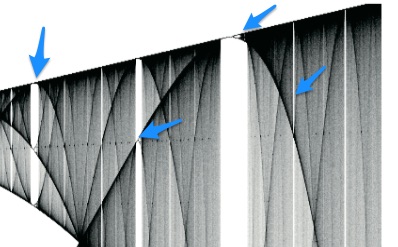
Multiple Trauma Vortex (1)
September 1, 2016 by Steve Hoskinson, MA, MAT
SHARE THIS ARTICLE
“What is it?” The client asked me this as she felt her head, all on its own, turn gently to the right — as if about to look at something over there. Her question meant, “What past trauma is this experience related to?”
So, here’s the fundamental problem. Even in somatic psychotherapy circles we still don’t appreciate enough just how fully physical behavior is. The implicit, or body memory, is not at all linear — not one event per behavior. There could be, and likely are, numerous events that might rise to threshold for recollection, and which are associated with any state, any emotion, any behavior. Memory functions by association — related groupings. In my OI Expert Master Class, “Multiple Trauma Vortex,” I spend time showing somatic therapists how that grouping happens.
Today, however, we will achieve a lot if we can come to a better understanding of how such explicit ‘memories’ arise.
In my previous blogs, I’ve talked about the importance of recognizing — from complexity science — how our complex systems operate, and how they make recognizable shifts in a 3-Phase pattern. Understanding these three phases will give us a better idea of what arises in each phase. These three phases are ubiquitous, and show up in numerous models and, of course, in myth — think of the Christian trinitarian doctrine, or Gurdjieff’s “Law of Three.” The Hindu tradition speaks of the trimurti, or three forms. The three forms (and functions) are: Shiva (destroyer/transformer), Vishnu (preserver) and Brahma (creator). Likewise, the three major three phases I articulate for clinical work are: Chaos, Complexity and Coherence; understanding all three is essential. Each of these phases is like a system within a system. Each must be recognized clearly, because they are so different from each other, that to treat Phase I like Phase III will not support a client’s development. If you have read my blogs, or trained in Organic Intelligence®, you know that much of the work is to facilitate the tendency toward Self-organization, which is Phase III, “Coherence.”
In this blog I want to talk about Phase I, “Chaos” as an exemplary model.
Phase 1
Phase 1 is called “Chaos” because the system’s constitution is inscrutable. Rather than being primarily self-organizing, it has a limited range of intense experience that’s assimilable. In fact, as with each Phase, it is self-reinforcing. This means that the system develops an unconscious attraction toward an intensity of experience that serves to repeatedly disorganize the system, knocking it back toward its impoverished threshold of tolerance.
Action is constant
This does not mean that a person whose system in this phase feels chaotic — some have learned to manipulate the environment so well that they successfully limit their exposure to unwanted intensity. Capable and intelligent leaders, managers, psychopaths, CEOs and presidential candidates are possible examples. For such a person in Phase 1 (Chaos), action is constant, trying to make sure the environment (social, physical, emotional, etc.) does not impinge too forcefully. The ability to control things outside oneself is of prime importance (think “control freak”). At the same time, however, the risk is not imaginary. Overexposure to toxic intensity can further ding the nervous system so that it becomes even less efficient, and less resilient. We see this consequence in persons who suffer systemic breakdowns, including some syndromal conditions such as chronic fatigue, fibromyalgia, migraine, etc.
If we think systemically we realize how profoundly metabolic are these processes and that top down interventions will have a limited effect. Asking a client whose system is in chaos to “resource” with any number of positive interventions may be necessary in the moment, but it will likely make no change in the overall way that system is organized. The system can dance to the tune being laid down, but will go back and hold the wall once that music stops. I’ve described above those who can keep the music going, those who can keep the top-down interventions going by controlling their focus of attention and managing the people around them.
But what about others? What about those who do not have the energetic, emotional or intellectual wherewithal to do prescribed meditations, affirmations, positive thinking, belly breathing, and sober living? They become further burdened with their failure to do the things their practitioners tell them will alleviate their sufferings. Sadly, this is where the infamous cycle of blaming the victim could be stimulated — clients who are doing their best cannot always do enough. The ensuing guilt disempowers.
There is an alternative. In a methodist fashion, I have defined observable steps as a system (our clients’) moves from Phase 1 (Chaos) to Phase 3 (Coherence). However, success in this progression depends on success in the transition from Phase 2 to Phase 3, and of course from Phase 1 to Phase 2.
In the midst of chaos, order breaks out
Take a look at this diagram below. It’s a section of what’s called a ‘bifurcation diagram’— a graphing of a nonlinear equation. For reasons I discuss elsewhere, it is an apt reflection of nervous system processes. In this diagram we see the mapping of a stage of ‘chaos.’ So many ‘bifurcations’ are happening that broad swaths are dark with them.
Except…
Those Blue arrows are places where there are bands of clear space. In the midst of chaos, order breaks out! Without knowing when or why, what is certain is that this system (like our nervous system) will spontaneously show up in moments of self-ordering. Our biology, as a social system and as a system uniquely oriented to its environment will learn to do this self-ordering more if it receives the right support at that moment. This is now simple reinforcement. One has only to become more nuanced in understanding what “better order” looks like behaviorally. Then we can become more adept at seeing these inevitable movements toward greater coordination in more and more subtle ways, and we are able to give a reinforcement that is immediate enough that it makes that ordering more likely to occur, with increasing frequency. Voila!
Positive reinforcement
This is Phase 1 work — a shaping paradigm of positive reinforcement. It takes time, and is done in conjunction with good rapport and continued support for the Phase 2 tools that add to the impulse of stabilization. In the free video library there are more detailed talks on this process. The point is this: each Phase requires unique interventions on the part of the therapist, and unique skill sets to be acquired by the client. The payoff is considerable. A client who works successfully in Phase 3 (Coherence) has a radically improved life experience compared to Phase 1 (or Phase 2).
The shift to Phase 3: Coherence
For clinicians adept in somatic, verbal and emotional observation, the shift to Phase 3 means also a shift for the client in what content emerges naturally. In Phase 1, the content will reflect chaos, and traumatic events, with a significant level of intensity. This is a simple rule of systems: stable systems are self-reinforcing. So, it makes sense that the content that emerges from a chaotic system will of course serve to reinforce that level of (dis)organization. It is for this reason that I teach my students how to work these systems and phases per se, and work from the implicit content based in Phase 1 and Phase 2 work. Trauma work tends to be far too much — even in traditions that teach about resourcing or titration. Similarly, asking a client to attend to sensation is most likely to upset the delicate balance that is trying to emerge organically. All interventions — including attending to the somatic experience — have to be simultaneously attuned to four dimensions:
1) the person and Being of the client,
2) their overall Phase (Chaos, Complexity, Coherent),
3) their in-the-moment-state (i.e. fight, flight, freeze, orientation/engagement), and
4) to the pattern of processing in relation to the system’s intensity thresholds (more on this in future blogs!)
One day I was working with a woman who sought help after an automobile accident. In the midst of OI’s classic ‘free association conversation’ she ‘recalled’ playing soccer with a friend as a child. As I expressed interest in the particulars of that event, she demonstrated what it would look like to take a shot on goal. Her right foot extended, her two hands extended in front, about to shoulder level, “When taking the shot you contort your body to disguise the shot.” Her implicit (body) movement looked exactly as if she were holding the steering wheel, jamming on the brake, and body leaning to the side as if to avoid the oncoming vehicle. Her ‘explicit’ story, however, was ‘playing an exciting soccer game with a friend.’
Implicit exposure
You see how this works? With the appropriate attuned support, her body provided this exciting ‘implicit exposure’ — while at the same time completely protecting her from the intensity which was associated with the explicit trauma story.
So, in Phase 3 (Coherence) when the explicit ‘trauma’ finally shows up, it does so often as the story with just enough extra intensity to support the growth to that system’s next threshold. It’s a near-miss, a near-trauma, or an event which has clear learning value to the client — but usually not the birth trauma, attachment story, head injury, etc., the trauma stories. The biology has another intention. Our systems want to grow. As we see in the diagram below, in Phase 3 each new ideal learning threshold is a small, rhythmic step up the ladder from the previously attained threshold. In this way, the states are close enough to create integration and continuity of experience.
Most importantly, however, is that the biology will recalibrate in relation to its learning thresholds. That is, a system learns by conditioning (by ‘feel’) what the appropriate and easeful level of intensity threshold is suited to the moment — in living, and in session. And, significantly, the explicit story that takes things to the next threshold — for instance the “near miss”— is then resonant with associated events of greater intensity. So the near miss accident has beneath it the serious injury accident, the whiplash, falling off the bike in fourth grade, the getting stuck in the birth canal, etc ! And, by working in this organic way, the whole stack can be simultaneously pinged and processed with subtle, sometimes sub-conscious evocation from a skilled clinician, often resulting in one of those single life-changing sessions. This work with the resonant associative network, the “stacks” of events which ultimately comprise a complex — this is the work of Multiple Trauma Vortex.
Want your MTV? Join me for the OI Expert Master Class Program, the fourth class is on this topic, and in future blog posts right here. Stay tuned!
Steve Hoskinson MA, MAT, is the Founder and CCO (Chief Compassion Officer) of Organic Intelligence and Organic Intelligence Outreach Institute, a 501(c)(3). Steve created the Human Empowerment Resiliency Training: OI HEARTraining® (a positive psychology, fractal method known for implicit exposure approach in trauma) based on his foundational experiences in psychology, theology, Somatic Experiencing®, Milton Erickson’s generative change work, mindfulness meditation and more.
This blog post was written for Somatic Psychotherapy Today and reposted with permission from SPT.
SHARE THIS ARTICLE





